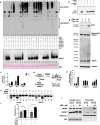PARP1-MGMT complex underpins pathway crosstalk in O6-methylguanine repair
- PMID: 36242092
- PMCID: PMC9563463
- DOI: 10.1186/s13045-022-01367-4
PARP1-MGMT complex underpins pathway crosstalk in O6-methylguanine repair
Abstract
DNA lesions induced by alkylating agents are repaired by two canonical mechanisms, base excision repair dependent on poly(ADP) ribose polymerase 1 (PARP1) and the other mediated by O6-methylguanine (O6meG)-DNA methyltransferase (MGMT) in a single-step catalysis of alkyl-group removal. O6meG is the most cytotoxic and mutagenic lesion among the methyl adducts induced by alkylating agents. Although it can accomplish the dealkylation reaction all by itself as a single protein without associating with other repair proteins, evidence is accumulating that MGMT can form complexes with repair proteins and is highly regulated by a variety of post-translational modifications, such as phosphorylation, ubiquitination, and others. Here, we show that PARP1 and MGMT proteins interact directly in a non-catalytic manner, that MGMT is subject to PARylation by PARP1 after DNA damage, and that the O6meG repair is enhanced upon MGMT PARylation. We provide the first evidence for the direct DNA-independent PARP1-MGMT interaction. Further, PARP1 and MGMT proteins also interact via PARylation of MGMT leading to formation of a novel DNA damage inducible PARP1-MGMT protein complex. This catalytic interaction activates O6meG repair underpinning the functional crosstalk between base excision and MGMT-mediated DNA repair mechanisms. Furthermore, clinically relevant 'chronic' temozolomide exposure induced PARylation of MGMT and increased binding of PARP1 and MGMT to chromatin in cells. Thus, we provide the first mechanistic description of physical interaction between PARP1 and MGMT and their functional cooperation through PARylation for activation of O6meG repair. Hence, the PARP1-MGMT protein complex could be targeted for the development of advanced and more effective cancer therapeutics, particularly for cancers sensitive to PARP1 and MGMT inhibition.
Keywords: Cancer therapy; DNA damage and repair; Ewing sarcoma; MGMT; O6-Methylguanine; PARP1; Protein interaction.
© 2022. The Author(s).
Conflict of interest statement
The authors declare that they have no competing interests.
Figures


References
-
- Smith MA, Reynolds CP, Kang MH, Kolb EA, Gorlick R, Carol H, et al. Synergistic activity of PARP inhibition by talazoparib (BMN 673) with temozolomide in pediatric cancer models in the pediatric preclinical testing program. Clin Cancer Res. 2015;21(4):819–832. doi: 10.1158/1078-0432.CCR-14-2572. - DOI - PMC - PubMed
-
- Schafer ES, Rau RE, Berg SL, Liu X, Minard CG, Bishop AJR, et al. Phase 1/2 trial of talazoparib in combination with temozolomide in children and adolescents with refractory/recurrent solid tumors including Ewing sarcoma: a children's oncology group phase 1 consortium study (ADVL1411) Pediatr Blood Cancer. 2020;67(2):e28073. doi: 10.1002/pbc.28073. - DOI - PMC - PubMed
-
- Smith MA, Hampton OA, Reynolds CP, Kang MH, Maris JM, Gorlick R, et al. Initial testing (stage 1) of the PARP inhibitor BMN 673 by the pediatric preclinical testing program: PALB2 mutation predicts exceptional in vivo response to BMN 673. Pediatr Blood Cancer. 2015;62(1):91–98. doi: 10.1002/pbc.25201. - DOI - PMC - PubMed
Publication types
MeSH terms
Substances
Grants and funding
LinkOut - more resources
Full Text Sources
Research Materials
Miscellaneous

